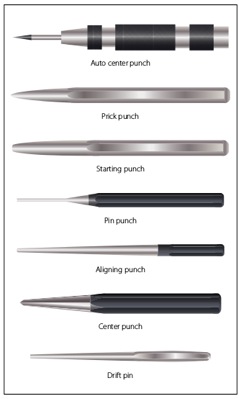Blog
Types of Punches and Their Uses
Types of Punches, Their Applications, and Safe Usage in Workshop Practice

Classification and Uses of Punches in Mechanical Engineering Workshops
Mechanical engineering workshops extensively use a variety of punches for marking, aligning, and removing components. Punches are essential hand tools used for locating centers for drilling, punching holes in sheet metal, removing damaged rivets, bolts, or pins, and transferring hole locations from templates or patterns. Some punches are solid, while others are hollow depending on their application.
Classification of Punches
Punches are generally classified based on the shape and purpose of their points. The most commonly used punches in mechanical workshops include:
1. Prick Punch
The prick punch is mainly used for making light reference marks on metal surfaces. It is ideal for transferring dimensions from a paper pattern directly onto metal.
Uses of Prick Punch:
-
Marking layout lines and reference points
-
Transferring measurements from templates or drawings
-
Light marking before cutting or shaping metal
To use a prick punch, place the paper pattern accurately on the metal surface and lightly tap the punch with a small hammer. This creates small indentations at critical points. Avoid heavy blows, as excessive force may bend the punch or damage the workpiece.
2. Center Punch
A center punch is used to make deeper and larger indentations in metal, especially before drilling operations. These indentations help guide the drill bit and prevent it from slipping.
Features and Uses:
-
Heavier than a prick punch
-
Typically ground to a 60° point angle
-
Used to start holes for drilling
Care should be taken not to strike too hard, as excessive force may deform or dimple the surrounding metal.
3. Drive Punch
The drive punch has a flat face instead of a pointed tip and is commonly used to drive out damaged or stuck rivets, bolts, and pins.
Characteristics:
-
Flat-faced tip
-
Sized by face width (e.g., 1/8 in, 1/4 in)
-
Tapered sides leading to the face
4. Pin Punch (Drift Punch)
A pin punch, also called a drift punch, has a straight shank and flat face. It is used after a drive punch to completely remove pins or bolts from holes once initial movement has been achieved.
Important Note:
Never use a prick punch or center punch for removing bolts or pins, as their pointed tips can spread the material, making removal more difficult.
5. Transfer Punch
A transfer punch is used to accurately transfer the location of holes from a template or pattern onto a metal surface.
Features and Uses:
-
Typically about 4 inches long
-
Tapered point followed by a short straight section
-
Tip resembles that of a prick punch
-
Ideal for marking drill locations through templates
Conclusion
Punches play a vital role in mechanical engineering workshops by improving accuracy, efficiency, and safety in metalworking operations. Selecting the correct type of punch—whether prick, center, drive, pin, or transfer punch—ensures precise results and prevents damage to tools and workpieces.
overall rating:
my rating:
log in to rate

